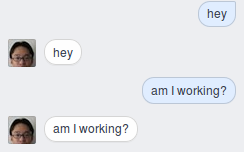Python Wrapper for Facebook Messenger Platform
Project description
Python Wrapper for Facebook Messenger Platform.
Disclaimer: This wrapper is NOT an official wrapper and do not attempt to represent Facebook in anyway.
About
This wrapper has the following functions:
send_text_message(recipient_id, message)
send_message(recipient_id, message)
send_generic_message(recipient_id, elements)
send_button_message(recipient_id, text, buttons)
send_quick_reply(recipient_id, text, buttons)
send_attachment(recipient_id, attachment_type, attachment_path)
send_attachment_url(recipient_id, attachment_type, attachment_url)
send_image(recipient_id, image_path)
send_image_url(recipient_id, image_url)
send_audio(recipient_id, audio_path)
send_audio_url(recipient_id, audio_url)
send_video(recipient_id, video_path)
send_video_url(recipient_id, video_url)
send_file(recipient_id, file_path)
send_file_url(recipient_id, file_url)
send_action(recipient_id, action)
send_raw(payload)
get_user_info(recipient_id)
You can see the code/documentation for there in bot.py.
The functions return the full JSON body of the actual API call to Facebook.
Register for an Access Token
You’ll need to setup a Facebook App, Facebook Page, get the Page Access Token and link the App to the Page before you can really start to use the Send/Receive service.
Installation
pip install pymessenger2Usage
from pymessenger2.bot import Bot
bot = Bot(<access_token>, [optional: app_secret])
bot.send_text_message(recipient_id, message)Note: From Facebook regarding User IDs
These ids are page-scoped. These ids differ from those returned from Facebook Login apps which are app-scoped. You must use ids retrieved from a Messenger integration for this page in order to function properly.
If app_secret is initialized, an app_secret_proof will be generated and send with every request. Appsecret Proofs helps further secure your client access tokens. You can find out more on the Facebook Docs
Sending a generic template message:
Generic Template Messages allows you to add cool elements like images, text all in a single bubble.
from pymessenger2.bot import Bot
from pymessenger2 import Element
bot = Bot(<access_token>)
elements = []
element = Element(title="test", image_url="<arsenal_logo.png>", subtitle="subtitle", item_url="http://arsenal.com")
elements.append(element)
bot.send_generic_message(recipient_id, elements)Output:

Generic Bot Output
Sending an image/video/file using an URL:
from pymessenger2.bot import Bot
bot = Bot(<access_token>)
image_url = "http://url/to/image.png"
bot.send_image_url(recipient_id, image_url)Todo
Structured Messages
Receipt Messages
Airlines
Tests!
Example

Screenshot of Echo Facebook Bot
You can find an example of an Echo Facebook Bot in examples/
Project details
Release history Release notifications | RSS feed
Download files
Download the file for your platform. If you're not sure which to choose, learn more about installing packages.
Source Distribution
File details
Details for the file pymessenger3-1.0.0.tar.gz.
File metadata
- Download URL: pymessenger3-1.0.0.tar.gz
- Upload date:
- Size: 8.8 kB
- Tags: Source
- Uploaded using Trusted Publishing? No
File hashes
| Algorithm | Hash digest | |
|---|---|---|
| SHA256 |
62feef3bc6ef3ceab65802449c92df84d51f9ad45e2703d3fcf1ed0ffc050374
|
|
| MD5 |
ef1bb06d6187de56ed1f12db07b97eac
|
|
| BLAKE2b-256 |
772bf417875610acfc7642c8344d74813b40bce15042e70be4c8b0821707e828
|









